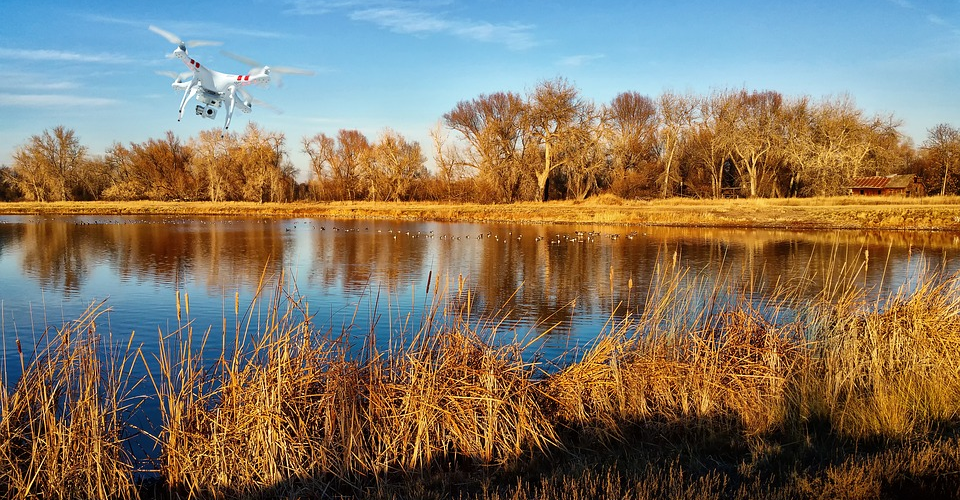10 Tips for Making Your Aerial Photography Business A Success
Aerial photography is one of the easiest drone-based businesses to get into. All you need is a high-quality camera drone, some photography skills, and a little post-processing knowledge. However, even if there’s hardly any technical hurdle when getting into drone photography, it’s not quite a certain path to success. There are probably thousands of professional drone photographers out there. To succeed, the first thing you need to do is to stand out. If you’re just breaking into the drone photography industry or if you’re currently struggling to get your business off the ground, then here are our best tips for you:
1. Take a flight training course
While it’s true that all it takes to be a drone photographer is the skill to fly a drone, aim its camera, and take shots, being a good drone photographer takes a little more training. Autonomous flight features are great and have been reliably helping drone photographers capture great shots effortlessly.
However, any professional drone pilot can benefit from learning how to fly their drone manually. Keep in mind that the jobs you accept can take you to unexpected places, and there may be times when you cannot rely on GPS stabilization. There are other handicaps that you’ll have to learn to fly with, such as the lack of obstacle avoidance technology. A proper drone flight training course should prepare you for such circumstances.
Aside from developing the skill in maneuvering your drone, a flight training course is also a good avenue to learn about best practices when it comes to flight safety. Safety standards can vary based on your location. Is it acceptable to fly over private property in your city or will you run the risk of running afoul of law enforcement? Are there going to be issues with flying over people even if it’s a sparsely populated area?
There’s currently no legal requirement for a professional drone pilot to undergo a formal training course. However, you owe it to yourself and to your future clients to be the best drone pilot that you can be. Finishing a drone flight training course – especially one that grants a certificate or a diploma – also beefs up your qualifications and will be very effective in marketing your services.
2. Use the right equipment

Just because there are literally dozens of popular camera drone models out there doesn’t mean that can go ahead and buy whatever catches your eye. Not all camera drones are made equal. For you to have any sort of success in drone photography, you’ll need to get a model that features a 4K camera and built-in gimbal stabilization. Those sound like pretty stiff requirements but trust us – you can’t compete in the drone photography market with an under-specced drone.
Most camera drones come with built-in autonomous photo modes that can help you capture good angles on your subjects without having to worry about maneuvering your drone. These photo modes vary from one model to another, even within the same brand. Our advice is to pick a drone model with autonomous modes that fit your photography style. If you are going to capture moving objects, then a good tracking or ‘follow me’ mode would be useful. On the other hand, an ‘orbit’ mode provides dynamic footage even on non-moving subjects.
Naturally, a drone with more advanced features will be more expensive. Take stock of your budget and pick a drone model that is within your means. Camera drones don’t need to be expensive – even the original DJI Mavic Pro is perfectly capable of professional-grade photos and videos. Of course, it wouldn’t hurt to get a more expensive drone if you have the budget for it. The DJI Phantom 4 Pro or the Yuneec Typhoon H Plus are equally good candidates for a high-end camera drone for your drone photography business.
3. Get some insurance

Despite all the advances made in drone technology in recent years, they are still not perfect machines. A strong gust of wind, an attack by birds, or even a momentary lapse by the drone pilot can lead to either a fly-away or a crash. In cases like these, you need a safety net so that your business can continue to exist despite the financial setbacks.
Much like any business owner, a professional drone pilot needs to take measures to secure their assets. Having a drone hull insurance is a good first step. In case your drone crashes or can no longer be recovered, a drone hull insurance policy can cover the costs of repair or replacement.
More critical for drone business owners is liability insurance. As you can imagine, a catastrophic drone crash can result in damage beyond just your drone. It can crash into someone else’s property, or worse, into unwitting bystanders. With such a high potential for third-party damage, a drone liability insurance has a much higher coverage – typically $1 million and above. Although the premiums of a liability insurance policy can make quite a dent on your budget, you’ll be extremely thankful when the time comes that you’ll be needing it.
If paying for annual coverage sounds too expensive for you, then you’ll be glad to know that there companies like Verifly and SkyWatch that offer on-demand drone insurance. All you need to do is to provide flight details using their mobile apps, and you will receive a quote for insurance overage just the number of hours of your planned flight mission. You can even print out an insurance certificate to show your clients. This is a much more affordable alternative to traditional insurance policy payment schemes and one that can be activated with short notice.
4. Build a professional website
You need a space to show off all the work you’ve completed, and this space needs to be professionally designed to attract potential clients. It’s not enough that your work is out there, but it has to be presented in a manner that reflects who you are as a person, an artist, and a professional.
A good website establishes your online presence. Take the time to come up with a catchy title and a memorable logo. If you can set up analytics that will track where your inbound clicks are coming from, it would be very useful in identifying your market.
There is a good number of web hosting solutions that cater especially to photographers. Wix, Zenfolio, or Pixpa are some of the most popular options. An easier option would be to use WordPress with a special portfolio plugin, like Envira Gallery. While you need to factor in the cost of web hosting in the recurrent expenses of your business, it isn’t very expensive. There are lots of web hosting solutions that cost somewhere between $150 to $250 per year.
5. Market yourself in social media

Even when your professional website has gone online, you shouldn’t underestimate the reach of social media. Whether on Facebook, Instagram, or Twitter, social media users will spread eye-catching aerial photos for free. Using these channels, that great drone shot you took of a sandbar or a hiking trail can spread organically and expand your market to the extent that is not possible with individual effort.
You can even make your own Instagram or Tumblr account that features all your best works. You can post new photos regularly and have your follows share them to their contacts. Consider it a much more casual portfolio with social elements.
These social media channels also have communities that can be a great source of knowledge. Sign up to an online community focusing on drone photography or drone flight in general so that you can stay up to date with the latest news, developments, and trends.
6. Decide on a pricing scheme
One of the first things an interested client will ask you before you come to an agreement is for how much you are offering your services. Your business will be much more welcoming by providing visitors to your website an upfront pricing scheme so that they can decide on their own. Of course, you should expect some customers to negotiate with you about your prices, so leave a little bit of room in your rates for potential discounts.
It’s your decision how you will charge your clients. Most drone photographers come up with a custom quote for each project depending on the lead time and deliverables. While this pricing scheme is flexible, it’s also more work for you creating quotes every time receive an inquiry from a potential customer.
Another popular alternative is to charge clients on a per hour basis. The total amount you can earn with this pricing scheme purely depends on the scope of the job. Taking photos for real estate advertising of a huge property will take a longer time than a similar job but for a smaller house. This is particularly effective when the job requires coverage of an event, as the number of hours of work you need to do can be more easily determined.
For us, the simplest pricing scheme is one that depends only on the deliverables. You can offer pre-set packages such as 20 aerial photos from 5 different angles for $300, or a combination of photos and videos for $500. There’s no guesswork in this pricing scheme, and potential customers don’t even need to get in touch with you to know what they are getting into.
7. Manage your expenses

While it can be tempting to hoard as many supplies and accessories for your drone as soon as you can, you still need to take stock of how much you are spending. If you’re only flying indoors, then you probably won’t need that fancy landing pad. If you’re not planning to do any jobs at night or during twilight, then there isn’t much need for anti-collision lights. Even something as basic as the choice of your drone could play a huge role on when your business starts to break even.
One more thing you’ll need to anticipate is that you will not be able to fly your drone outdoors in rainy season or during winter. In fact, this can be a very slow time for commercial drone pilots. You need to factor this slow-down in earnings into your business plan so that you don’t end up getting surprised that you’re operating at a loss.
8. Work for free (sometimes)
In an ideal world, you will be paid for every aerial photo or video your produce. Reality isn’t quite that simple. There are times when you simply need to bite the bullet and do a job not for cash, but for exposure. This could be a good idea if your aerial photo gets featured in a major publication, for the advertisement of a popular brand, or on a website with large readership. Just make sure, when you come to terms with the client, that your work is credited.
The exposure that you get from these clients may prove to be even more valuable than the cash amount that you could have earned. Our advice is to go ahead and take that pro bono job and add it right away to your portfolio or resume. In a drone photography that is already saturated with talented photographers, every little bit of extra publicity counts.
9. Find your niche
In the same way that specialty doctors earn more than general practitioners, a drone photographer who is an expert in one area can command a much higher rate. A portfolio with a consistent theme – whether it’s nature shots, weddings, or real estate properties – is more coherent and will better draw in the right customers.
Pick a niche that is either interesting to you or one where you really excel at. This niche could be something as simple as covering weddings, parties, or sport events. Drone use in real estate advertising seems to be on the rise, so that’s something you might want to consider. With some more experience, you can even outgrow drone photography and move on to more specialized drone applications such as industrial inspection and 3D mapping.
10. Keep building your network
While it’s true that success attracts even more success, you’ll still need to make an effort to seek it out. To make your business successful, you will need to reach out to potential clients now and then. This can be done by traditional means such as sending cold e-mails or making cold calls.
For best results, target customers in the niche that you have chosen. If you specialize in real estate advertising, then draft a list of real estate agents in your area or even hotels and resorts who might be interested in capturing aerial photos of their properties for marketing. If your experience is in wedding coverage, then how about partnering up with wedding planners or getting a booth at a bridal trade expo? Old-fashioned as these methods may seem, they are still very effective.
Bonus tip: Prepare a business plan
If there’s any single secret to success, then it is starting with a plan. A good business plan lays out the entire road that you’ll need to follow towards success. From establishing your company’s identity to identifying the services you will be offering, how you will be marketing them, and the milestones you want to reach at any point in time, a good business plan keeps you from losing sight of your goal.
If you’ve followed the tips we have outlined above, then you’ve already got the workings of a properly made business plan. Keep in mind that a business plan isn’t something you come up with and tuck away forever, never to be seen again. You need to review it now and then and check if you are achieving your milestones and goals. Should that not be the case, then you know that there’s a problem and that something needs to be done.
Final thoughts
We’ve often said that the best time to get into a drone-based business is now. This is especially true for aerial photography, an industry that is quick to become saturated since there isn’t much of a barrier for entry.
The key is to stand out by consistently producing high-quality output and maintaining good relationships with your client. You also need to be marketing-savvy, identifying your customers, and getting in touch with them using smart (or old-fashioned) marketing methods. With so much competition, it’s often not enough to be a good aerial photographer. You need to plan ahead, be cunning and charming at the same time, and follow up on good leads. It takes effort at every step of the way – that drone isn’t going to fly itself.

